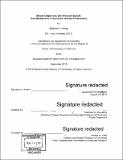| dc.contributor.advisor | Matthew D. Shoulders. | en_US |
| dc.contributor.author | Wong, Madeline Y | en_US |
| dc.contributor.other | Massachusetts Institute of Technology. Department of Chemistry. | en_US |
| dc.date.accessioned | 2019-03-11T19:36:49Z | |
| dc.date.available | 2019-03-11T19:36:49Z | |
| dc.date.copyright | 2018 | en_US |
| dc.date.issued | 2018 | en_US |
| dc.identifier.uri | http://hdl.handle.net/1721.1/120902 | |
| dc.description | Thesis: Ph. D., Massachusetts Institute of Technology, Department of Chemistry, 2018. | en_US |
| dc.description | Page 176 blank. Cataloged from PDF version of thesis. | en_US |
| dc.description | Includes bibliographical references. | en_US |
| dc.description.abstract | Approximately one-third of all cellular proteins traverse the secretory pathway. After translation and folding in the endoplasmic reticulum (ER), proteins are transported through the Golgi to their final locations inside or outside of cells. At each step, proteins are helped by chaperones, which both shepherd proteins towards their native structures and serve as gatekeepers for export. Many proteins in the secretory pathway are also modified by installation of polysaccharides on specific asparagine residues. These N-glycans are installed in the ER as uniform precursors, but are trimmed and built up by Golgi glycan maturation enzymes into a striking array of epitopes. N-glycans act as a second mechanism to stabilize protein structure and prevent the release of misfolded proteins. Outside the cell, N-glycans on cell surfaces and secreted, soluble proteins allow cells to interact with each other, with their environment, and with distal tissues. During development, cells encounter physiological ER stress incurred by high levels of sustained protein production. Unresolved protein misfolding, on the other hand, results in pathological ER stress and tissue dysfunction. Prior work has used small model substrates to show that cells utilize secretory pathway chaperones and tune N-glycosylation to respond to ER stress. This thesis examines how cells use similar strategies to accommodate challenging cargoes such as collagen-1. In the human body, collagen-I constitutes the primary protein component of bone, skin, and other organs; collagen-I misfolding results in pathological ER stress and connective tissue diseases. We therefore set out 1) to identify cellular components required for collagen-I secretion that could be targeted to address disease and 2) to assess the effects of ER stress on both cellular N-glycan structures and individual glycoproteins. Here, we employ a high-throughput assay for collagen-I secretion and find that the cytosolic isoform of Hsp90 is required for collagen-I export. We also show that intracellular stress signaling alters the structures of cell surface and secreted N-glycans. Finally, we demonstrate that the collagen-I N-glycan buffers collagen-I folding against destabilizing mutations and ER stress. Our results identify potential therapeutic leads for collagen misfolding diseases and point to new mechanisms for maintaining secretory pathway proteostasis. | en_US |
| dc.description.statementofresponsibility | by Madeline Y. Wong. | en_US |
| dc.format.extent | 176 pages | en_US |
| dc.language.iso | eng | en_US |
| dc.publisher | Massachusetts Institute of Technology | en_US |
| dc.rights | MIT theses are protected by copyright. They may be viewed, downloaded, or printed from this source but further reproduction or distribution in any format is prohibited without written permission. | en_US |
| dc.rights.uri | http://dspace.mit.edu/handle/1721.1/7582 | en_US |
| dc.subject | Chemistry. | en_US |
| dc.title | Distant chaperones and N-glycan signals : new mechanisms of secretory pathway proteostasis | en_US |
| dc.type | Thesis | en_US |
| dc.description.degree | Ph. D. | en_US |
| dc.contributor.department | Massachusetts Institute of Technology. Department of Chemistry | |
| dc.identifier.oclc | 1088896599 | en_US |
